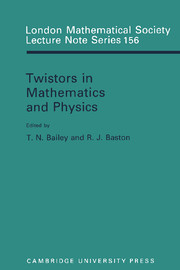Book contents
- Frontmatter
- Preface
- Contents
- 1 Twistor Theory After 25 Years—its Physical Status and Prospects
- 2 Between Integral Geometry and Twistors
- 3 Generalized Conformal Structures
- 4 Riemannian Twistor Spaces and Holonomy Groups
- 5 Twistors, Ambitwistors, and Conformal Gravity
- 6 The Penrose Transform
- 7 Notation for the Penrose Transform
- 8 The Twistor Transform
- 9 Invariant Operators
- 10 Penrose's Quasi-local Mass
- 11 The Sparling 3-form, Ashtekar Variables and Quasi-local Mass
- 12 Twistors and Strings
- 13 Integrable Systems in Twistor Theory
- 14 Twistor Characterization of Stationary Axisymmetric Solutions of Einstein's Equations
- 15 A Two-surface Encoding of Radiative Space-times
- 16 Twistors, Massless Fields and the Penrose Transform
- 17 Twistor Diagrams and Feynman Diagrams
- 18 Cohomology and Twistor Diagrams
- Authors' addresses
15 - A Two-surface Encoding of Radiative Space-times
Published online by Cambridge University Press: 05 May 2013
- Frontmatter
- Preface
- Contents
- 1 Twistor Theory After 25 Years—its Physical Status and Prospects
- 2 Between Integral Geometry and Twistors
- 3 Generalized Conformal Structures
- 4 Riemannian Twistor Spaces and Holonomy Groups
- 5 Twistors, Ambitwistors, and Conformal Gravity
- 6 The Penrose Transform
- 7 Notation for the Penrose Transform
- 8 The Twistor Transform
- 9 Invariant Operators
- 10 Penrose's Quasi-local Mass
- 11 The Sparling 3-form, Ashtekar Variables and Quasi-local Mass
- 12 Twistors and Strings
- 13 Integrable Systems in Twistor Theory
- 14 Twistor Characterization of Stationary Axisymmetric Solutions of Einstein's Equations
- 15 A Two-surface Encoding of Radiative Space-times
- 16 Twistors, Massless Fields and the Penrose Transform
- 17 Twistor Diagrams and Feynman Diagrams
- 18 Cohomology and Twistor Diagrams
- Authors' addresses
Summary
Introduction
The purpose of this work it to represent an alternative approach or description of the geometry of asymptotically simple space-times [1]. The essential idea behind this approach is the attempt to analyze the gravitational field at any given interior point of a space-time using the imprint left at null infinity by light originating from that point. To be more specific, given a point xμ and its future (or past) light cone Nx, the light cone cuts of null infinity are defined as Cx = Nx⋂I, where I, null infinity, is the null boundary attached to an asymptotically simple space-time [2]. One then shows that knowledge of the geometry of the cut Cx and the neighboring cuts, for an arbitrary point xμ, is equivalent to knowledge of the conformal metric at that point [1]. (These cuts have actually been explicitly calculated and the conformal metrics reconstructed in the case of the Schwarzschild, Kerr and charged Kerr metrics [1].)
Though the goals of this formalism have been out lind elsewhere [3] one can say that the main areas of research in the program are: a) kinematical description of the cuts, b) dynamical description of the cuts, and c) quantum description of the cuts.
The main purpose of the present work is to present some new results concerning part a) of the program, though towards the end we will make comments on part b).
- Type
- Chapter
- Information
- Twistors in Mathematics and Physics , pp. 283 - 298Publisher: Cambridge University PressPrint publication year: 1990



